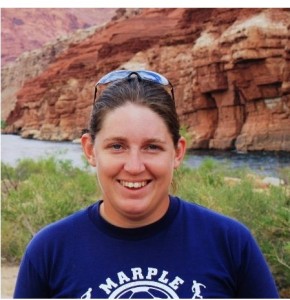Jennifer C. Rankin – shares a ‘Day of Archaeology’ (07/25/13)
back]

Jennifer C. Rankin
Archaeologist at URS Corporation
Graduate Student at Temple University
Philadelphia, Pennsylvania, USA
I have just returned to my office in Burlington, NJ (USA) after spending most of the month of July on an archaeological survey in the Pocono Mountains of northeastern Pennsylvania (USA). During the survey, we identified several historical period farmsteads and one significant Native American Woodland-period occupation along the Lehigh River. Today, I reviewed the data and the results of a geomorphological study completed by Dr. Frank Vento of Clarion University, his students (Ethan Mott and Devin Kuberry), and myself. I also assisted Lou Magazzu on developing a display case for the public that is part of the I-95/GIR Improvement Corridor Project (roadwork that will upgrade a major highway within the city of Philadelphia.) The display will draw upon new findings produced by URS Corporation, which is the company I work for. The cultural resources division of URS (a civil engineering company) is conducting this archaeological resource study for the Pennsylvania Department of Transportation in advance of the road construction developments. The display will highlight Native American settlements that once existed within what is now the city of Philadelphia. URS recently recovered a bifurcated projectile point dating (broadly) between 6500 and 5000 years ago that represents the earliest stone tool recovered from the Philadelphia region. We hope to soon recover a radiocarbon sample that will provide a more absolute date.
After my day at the office, my evening was spent at Temple University in Philadelphia, PA, where I am a graduate student in the Department of Anthropology earning a Ph.D. degree. I worked on the artifact collection from my dissertation site which is a Native American site located outside of Hamburg, PA (USA). The site dates from the Late Paleoindian period (10,000 years ago) through to the Late Archaic period (1200 years ago). My specific research interest is the earlier periods of prehistory (10,000 to 8000 years ago). Today’s work focused on a particular aspect of the assemblage that involved lithic (stone) raw material procurement and thermal (heat applied) alterations to those materials, which allowed for more controlled flaking in the production of stone tools. I will be conducting an experiment that tests thermal alterations of a very specific chert source from New York State that commonly does not exhibit alterations in the archaeological record. The exception to this is my dissertation site and several nearby sites dating to the same time period.
by admin